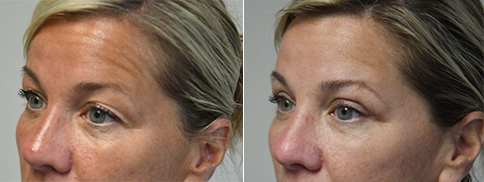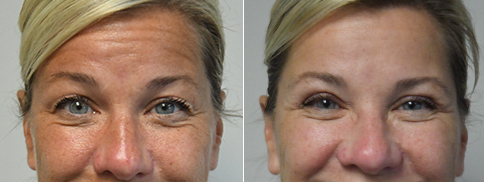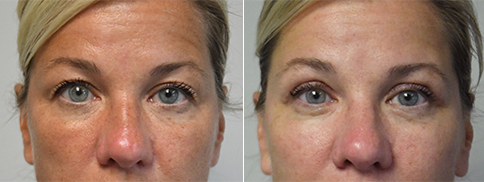What is Blepharoplasty?
Blepharoplasty, or eyelid surgery, in Boston and Worcester, Massachusetts, is performed to improve the issue of excess sagging skin on the upper or lower eyelids. Under-eye puffiness and bags may also be addressed, which can often lead to patients looking older or more tired than they are. For most patients wishing to correct irregularities surrounding their eyes, blepharoplasty may be the ideal solution.
Am I a good candidate for Blepharoplasty?
Eyelid surgery is suitable for both men and women who are physically healthy, psychologically stable and realistic in their expectations of the procedure. Typically, patients opting to undergo eyelid surgery are thirty five years or older, although for patients with sagging eyelids that are hereditary it may be performed at an earlier age. It should be noted that individuals with serious eye conditions or that smoke may not be candidates for eyelid surgery.
Blepharoplasty Patient #21-2
(3-month follow up) The patient received a lower eyelid blepharoplasty with fat grafting of the face.
Lower Eyelid Blepharoplasty #21
A woman of color in her early 60s is bothered by the aged appearance of her face and lower eyelids. She is shown before and again, 4 weeks after a trans-conjunctival lower lid blepharoplasty combined with fat grafting of the face. She has a little thickening of one of the puncture sites just lateral to the right ala of the nose and we will have her start topical silicone.
In addition to having a prominent lower eyelid fat pad which was removed with the surgery through the inside of the eyelid (“trans-conjunctival”), she has some of the typical volume loss of aging which was replaced around the eyes and the cheeks with the fat grafting.
The Vitality fat processing system from Sientra was used to process her fat before grafting. This uses a proprietary system to wash the fat, and remove oil and impurities and has been shown to increase the viability of the fat cells and the long-term take of the fat over other methods. At one month it is too early to assess the survival of her fat grafting but she has minimal inflammation at this time.
Blepharoplasty #21
An 80-year-old woman with obstruction of her upper visual field from excess skin and drooping of the brows ( brow ptosis) She is shown before and again, nearly 6 months after bilateral browpexy combined with upper eyelid blepharoplasty. Her vision has improved and she loves her new appearance. A browpexy anchors the cut edge of the lateral orbicularis muscle to the orbital rim periosteum and prevents the brows from dropping down. It can be a good compromise for patients with brow ptosis who do not wish a complete brow lift procedure at the time of upper eyelid blepharoplasty.
Blepharoplasty Patient #20
A woman in her mid-50s is shown before and again, 5 ½ months after upper eyelid blepharoplasty combined with brow-pexy.
Discussion:
As patients age, the face loses volume and the brows descend. When there is lateral brow descent and “hooding”, a blepharoplasty alone will not correct the problem. A brow lift can be done to pull up the forehead and gives good results when combined with upper eyelid blepharoplasty. However, not all patients want this much surgery. A brow-pexy is an in-between solution, that does not raise the eyebrows but “pexes” or fixes them with sutures in the area of the orbital rim so that they do not drop further when a patient sits up.
Blepharoplasty Patient #19
A woman in her mid-50s with brow ptosis ( deflation and descent of the brows from aging) as well as excess skin on her upper eyelids. She is shown before and again, 6 weeks after bilateral upper eyelid blepharoplasty combined with browpexy.
Discussion: As we age our tissues deflate and our brow drops. She is seen to have transverse forehead lines at rest as she works to hold her eyebrows out of the way with her frontalis muscles. Although she could consider a brow lift, she elevated for a simpler brow pexy- this does not elevate the brows but prevents them from dropping further. It is done through the blepharoplasty procedure. After surgery, we can see that her forehead lines are relaxed as she no longer has to work unconsciously to hold her eyebrows up. Scars are at their pinkest at 6 weeks and will begin to fade and improve over the next 6 months or longer. Her appearance is “refreshed” in a natural way and she no longer has problems with her upper visual field being blocked by the excess skin.
Frequently Asked Questions About Blepharoplasty
How is Blepharoplasty done?
Blepharoplasty is completed in about an hour with the help of a local anesthetic. During surgery, any unwanted excess skin will be removed. Incisions are closed with removable sutures, skin adhesives, or surgical tape.
Will I have any scars?
Eyelid surgery incisions are generally placed in a location where the scars will be concealed within the natural configuration of the eyelid. Therefore, scars from eyelid surgery are not regularly visible.
What should I expect during recovery?
During eyelid surgery recovery, patients may experience light bruising, swelling, or irritation to the eyes. Any discomfort is aided with pain medication, ointment, or cold compresses. Recovery time will vary, but everyday activities can normally be resumed after 10 days. It is also imperative that patients avoid direct sunlight to the eye area until the healing process is complete. Dr. Hall will provide you with specific instructions to ensure a safe and quick recovery.
How long will results last?
Results from both upper and lower blepharoplasty are long lasting. Once fat and excess skin are removed from the lower eyelid or under the eye, it will not regenerate.

“I saw 3 surgeons before meeting with Dr. Hall and by far he and his staff was the most compassionate, thorough, professional and helpful. Can’t say how pleased and comfortable he and his staff made me feel.”
Real Patient Ratings™ Review









Cosmetic & Plastic Surgery Specialist
"I treat my patients like I would treat
- Jonathan D. Hall, MD, FACSmembers of my own family."
Schedule Consultation